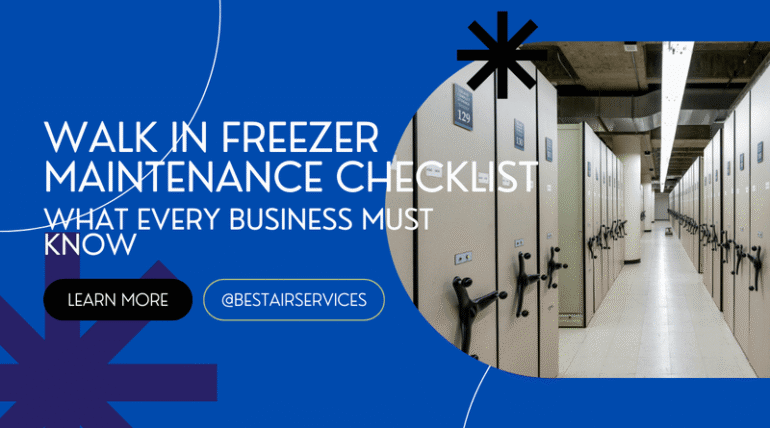
September 15, 2025
For companies in Ajman, Dubai, and throughout the United Arab Emirates that depend on frozen storage for perishables, medications, and food, a walk-in freezer maintenance checklist is crucial. Not only can a dependable freezer preserve goods, but it can also minimize downtime, save energy expenses, and prevent expensive repairs. BestAir Services offers you professional advice to maintain your walk-in freezer operating at its best year after year, supported by data and standards.
Why Regular Maintenance Matters
According to global market reports, the walk in coolers & freezers market is projected to grow from USD 12.67 billion in 2021 to USD 20.22 billion by 2028, reflecting growing demand for reliable cold storage.
Studies show that neglected condenser coils, damaged door seals, and blocked airflow rank among the top causes of compressor failure and energy inefficiency in refrigeration systems. Frequent preventive maintenance can reduce energy usage by up to 10-20% and extend system life by several years.
It’s crucial to maintain the right internal temperature, tight seals, clean coils, appropriate defrost cycles, and dependable controls because they protect you from food spoilage, fines from the government, and interruptions to business operations.
Walk In Freezer Maintenance Checklist
Everyday Tasks
- Verify the temperature inside: Check that it falls within the specified range, which, depending on the product type, is typically -18°C to -23°C or 0°F to -10°F.
- Check for leaks, wear, or damage to door gaskets and seals. Make sure doors close correctly and clean them.
- Remove anything that is obstructing the freezer’s airflow, such as fans, shelves, or vents.
- Check that the lights, fans, and alarms are operating properly.
Weekly Tasks
- Check for ice or frost accumulation on the evaporator coil and defrost if necessary.
- Clear the floors, walls, and surfaces of any dirt, mold, spills, or ice.
- To stop water leaks, inspect drain lines and pans and remove any obstructions.
- Look for odd vibrations or noises coming from the compressor, fan, or motor.
Monthly Tasks
- Dust and debris should be removed from the external condenser unit or condenser coils. It might be necessary to clean outdoor units more frequently.
- Tighten electrical connections and look for frayed wiring, burn marks, or corrosion.
- Check for leaks and make sure the refrigerant levels and pressure match the manufacturer’s specifications.
- Check the controls and thermostat calibration: Verify the accuracy of the temperature readings.
Seasonal and Quarterly Tasks
- Evaporator and condenser coils should be thoroughly cleaned; any damage to the fins should be inspected and fixed.
- Examine the panels, seams, and door frames for insulation integrity. Damaged insulation should be sealed or replaced.
- Verify the threshold, latches, and door hinges for correct alignment.
- To find any sleeping problems, look over usage logs (door opens, product load, usage patterns).
Annual / Professional Tasks
- Complete system inspection by a certified technician, including safety controls, motor bearings, compressor health, and defrost timer.
- Replace worn parts such as gaskets, filters, and fan belts.
- Assess energy use by adding better door seal materials, more effective defrost algorithms, and upgraded insulation.
- Verify adherence to relevant regional food safety and health regulations.
Technical Standards & Compliance
- Make sure the food safety and cold storage regulations in your area are met by your walk-in freezer.
- Use globally accepted design standards for parts such as gasket materials, door R-values, and insulation panels.
- To increase energy efficiency, for instance, many jurisdictions are revising their energy conservation requirements for walk-in refrigeration systems.
Real World Example
After using BestAir Services’ monthly maintenance checklist, which included cleaning condenser coils, replacing gaskets, and enhancing defrost cycles, one commercial cold storage facility in Ajman reported a 30% decrease in energy bills. The system uptime greatly increased and the compressor load decreased.
BestAir’s Expertise
- Maintenance of walk-in freezers in Ajman and the UAE for more than ten years.
- Certified refrigeration technicians with training in food-grade hygiene standards, energy codes, and safety.
- Authoritative procedures derived from current market trends and international manuals.
- Contracts for preventive maintenance, reporting, and scheduling that are transparent to guarantee complete trust.
Q&A: Walk In Freezer Maintenance Checklist
Ideal temperature is typically between −18°C to −23°C (0°F to −10°F) depending on product type (seafood vs meat vs ice cream). Deviations may increase energy consumption or spoil product.
Inspect monthly; typically replacement every 2–3 years or sooner if signs of wear, cracks, or leakage. Bad gaskets can increase energy use by 5–10%.
If you see recurring temperature problems, ice buildup, compressor short cycling, odd noise, or after 12 months of operation without professional check.
Yes, dirty coils increase condensing pressure, make compressors run harder, increasing wear and failure risk. Compressor replacement is far more expensive than routine maintenance.
You should expect clear reporting, preventive schedule, usage logs, compliance with hygiene and safety codes, genuine replacement parts, and fast corrective service when needed.
Conclusion
Inventory protection, energy savings, fewer emergency repair bills, and regulatory compliance are all achieved with a well-maintained walk-in freezer. To guarantee expert, dependable maintenance schedules and services in Ajman and across the United Arab Emirates, use this walk-in freezer maintenance checklist as the basis for your facility management and collaborate with BestAir Services.
📞 To arrange your freezer inspection or maintenance audit and enable your cold storage to function at its best, get in touch with us right now.


